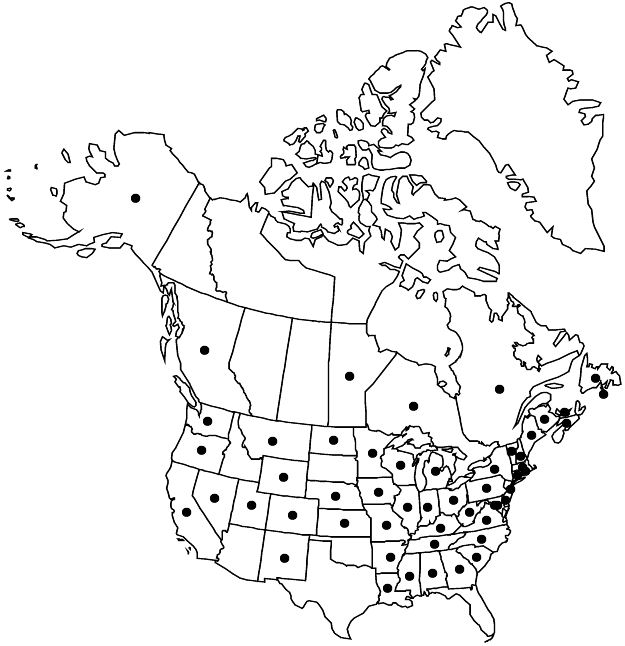Difference between revisions of "Malus domestica"
Theor. Prakt. Handb. Forstbot. 2: 1272. 1803, name conserved.
TammyCharron (talk | contribs) |
RevisionBot (talk | contribs) m (Bot: Adding category Revised Since Print) |
||
| (2 intermediate revisions by 2 users not shown) | |||
| Line 59: | Line 59: | ||
|distribution=St. Pierre and Miquelon;B.C.;Man.;N.B.;Nfld. and Labr. (Nfld.);N.S.;Ont.;P.E.I.;Que.;Ala.;Alaska;Ark.;Calif.;Colo.;Conn.;Del.;D.C.;Ga.;Ill.;Ind.;Iowa;Kans.;Ky.;La.;Maine;Md.;Mass.;Mich.;Minn.;Miss.;Mo.;Mont.;Nebr.;Nev.;N.H.;N.J.;N.Mex.;N.Y.;N.C.;N.Dak.;Ohio;Oreg.;Pa.;R.I.;S.C.;Tenn.;Utah;Vt.;Va.;Wash.;W.Va.;Wis.;Wyo.;c Asia;introduced also in Mexico;Central America (El Salvador;Guatemala);South America (Argentina);Europe;e Asia;Africa (South Africa);Pacific Islands (New Zealand;Tristan da Cunha);Australia. | |distribution=St. Pierre and Miquelon;B.C.;Man.;N.B.;Nfld. and Labr. (Nfld.);N.S.;Ont.;P.E.I.;Que.;Ala.;Alaska;Ark.;Calif.;Colo.;Conn.;Del.;D.C.;Ga.;Ill.;Ind.;Iowa;Kans.;Ky.;La.;Maine;Md.;Mass.;Mich.;Minn.;Miss.;Mo.;Mont.;Nebr.;Nev.;N.H.;N.J.;N.Mex.;N.Y.;N.C.;N.Dak.;Ohio;Oreg.;Pa.;R.I.;S.C.;Tenn.;Utah;Vt.;Va.;Wash.;W.Va.;Wis.;Wyo.;c Asia;introduced also in Mexico;Central America (El Salvador;Guatemala);South America (Argentina);Europe;e Asia;Africa (South Africa);Pacific Islands (New Zealand;Tristan da Cunha);Australia. | ||
|introduced=true | |introduced=true | ||
| − | |discussion=<p><i>Malus domestica</i> is cultivated for its edible apple. Historically, the nomenclature of the orchard apple has been confusing, with many species names applied to | + | |discussion=<p><i>Malus domestica</i> is cultivated for its edible apple. Historically, the nomenclature of the orchard apple has been confusing, with many species names applied to edible apple, e.g., <i>M. communis</i> Desfontaines, <i>M. domestica</i> Borkhausen (superfluous and illegitimate), <i>M. paradisiaca</i> (Linnaeus) Medikus, and <i>M. sylvestris</i> (Linnaeus) Miller. Quian G. Z. et al.’s proposal (2010) to conserve the illegitimate name <i>M. domestica</i> as <i>M. domestica</i> (Suckow) Borkhausen was accepted by the Nomenclature session at the XIX International Botanical Congress in July 2017, held at Shenzhen, China. The legitimation of the name <i>M. domestica</i> in the Shenzhen code is accepted by the author and now followed in FNA’s digital treatment of <i>Malus</i>.</p><!-- |
| − | --><p>Some trees, although originally planted, may appear naturalized when found in old, overgrown areas. Naturalized trees are derived from seeds distributed by birds and mammals and from apples discarded by people. Trees grown from seeds often produce small, bitter, and sour fruit.</p> | + | --><p>Some trees, although originally planted, may appear naturalized when found in old, overgrown areas. Naturalized trees are derived from seeds distributed by birds and mammals and from apples discarded by people. Trees grown from seeds often produce small, bitter, and sour fruit.</p> |
|tables= | |tables= | ||
|references= | |references= | ||
| Line 91: | Line 91: | ||
}}<!-- | }}<!-- | ||
| − | -->[[Category:Treatment]][[Category:Malus]] | + | --> |
| + | |||
| + | [[Category:Treatment]] | ||
| + | [[Category:Malus]] | ||
| + | [[Category:Revised Since Print]] | ||
Latest revision as of 17:31, 28 May 2021
Trees, 20–100(–150) dm. Stems 5–30 cm diam.; bark dark gray or gray-brown, scaly; young branches dark brown or reddish brown, densely tomentose, becoming glabrous; flowering shoots becoming spurs, 40–150 mm. Buds dark red or purple, ovoid, 3–4(–5) mm, scale margins densely puberulous. Leaves convolute in bud; isomorphic; stipules deciduous, lanceolate, 3–5 mm, apex acuminate; petiole 10–35 mm, tomentose to sparsely pubescent; blade elliptic, ovate, or broadly elliptic, (2–)5–10 × (1–)3–6.5 cm, base broadly cuneate or rounded, margins unlobed, obtusely serrate, sometimes serrate-crenate, apex acute, abaxial surface glabrescent, adaxial densely puberulent. Panicles umbel-like; peduncles absent; bracteoles deciduous, filiform, 5–7 mm. Pedicels 10–25 mm, puberulous. Flowers 30–40 mm diam.; hypanthium tomentose; sepals reflexed at flowering, triangular-lanceolate or triangular-ovate, 6–8 mm, equal to or longer than tube, apex acuminate, surfaces tomentose; petals (rose in bud) white, sometimes pink, obovate, 15–25 mm, claws 1 mm, margins entire, apex rounded; stamens 20, 9–10 mm, anthers yellow before dehiscence; styles 5, basally connate less than 1/2 length, 9–10 mm, slightly longer than stamens, basally gray-tomentose; stigmas green. Pomes green, yellow, or red, pure, striped, or blushed, globose or depressed-globose, 20–50(–70) mm diam., skin with bloom or wax, sometimes russetted or dotted, cores enclosed at apex; sepals persistent, erect; sclereids absent. Seeds light brown. 2n = 34 (51, 68).
Phenology: Flowering Apr–May; fruiting Jul–Oct.
Habitat: Abandoned or naturalized in thickets, forests, fields, fence edges, shores, roadsides
Elevation: 0–1600 m
Distribution

Introduced; St. Pierre and Miquelon, B.C., Man., N.B., Nfld. and Labr. (Nfld.), N.S., Ont., P.E.I., Que., Ala., Alaska, Ark., Calif., Colo., Conn., Del., D.C., Ga., Ill., Ind., Iowa, Kans., Ky., La., Maine, Md., Mass., Mich., Minn., Miss., Mo., Mont., Nebr., Nev., N.H., N.J., N.Mex., N.Y., N.C., N.Dak., Ohio, Oreg., Pa., R.I., S.C., Tenn., Utah, Vt., Va., Wash., W.Va., Wis., Wyo., c Asia, introduced also in Mexico, Central America (El Salvador, Guatemala), South America (Argentina), Europe, e Asia, Africa (South Africa), Pacific Islands (New Zealand, Tristan da Cunha), Australia.
Discussion
Malus domestica is cultivated for its edible apple. Historically, the nomenclature of the orchard apple has been confusing, with many species names applied to edible apple, e.g., M. communis Desfontaines, M. domestica Borkhausen (superfluous and illegitimate), M. paradisiaca (Linnaeus) Medikus, and M. sylvestris (Linnaeus) Miller. Quian G. Z. et al.’s proposal (2010) to conserve the illegitimate name M. domestica as M. domestica (Suckow) Borkhausen was accepted by the Nomenclature session at the XIX International Botanical Congress in July 2017, held at Shenzhen, China. The legitimation of the name M. domestica in the Shenzhen code is accepted by the author and now followed in FNA’s digital treatment of Malus.
Some trees, although originally planted, may appear naturalized when found in old, overgrown areas. Naturalized trees are derived from seeds distributed by birds and mammals and from apples discarded by people. Trees grown from seeds often produce small, bitter, and sour fruit.
Selected References
None.